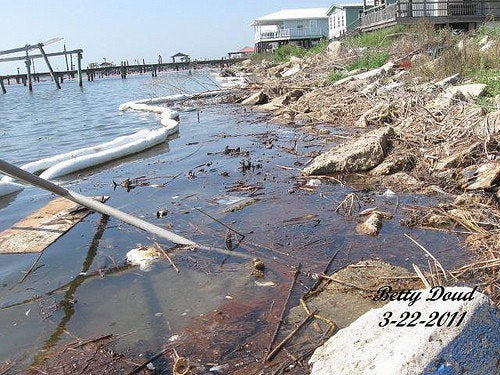
The Times Picayune is reporting that a Houston based company, Anglo-Suisse Offshore Partners, has taken responsibility for leaking Louisiana crude from a non-producing well that has contaminated Louisiana coastal beaches and wetlands and created a slick that spread for miles offshore.
The newspaper earlier reported that state officials had fingered work being done to the Anglo-Suisse's non-producing oil well near Southwest Pass of the Mississippi River as the likely source, calling it a "well capping out of control." Anglo Suisse Offshore Partners released a statement last night confirming it was the source of the spill, but that it was "surprised" that its dormant well could have released that much oil, according to the paper. The Times Picayune reported the well was being capped for permanent abandonment and that the operators told the Coast Guard it had been leaking only small amounts of oil.
In three reports to the Coast Guard since Friday, the company had reported that less than 5 gallons of crude had escaped. But state Wildlife and Fisheries agents traced the oil to the Anglo-Suisse well at its Platform E facility on Monday afternoon and found a crew on a boat trying to close in the well with a remotely operated submarine.
National networks are also covering the story as incredulous residents are once again dealing with an oil threat that could damage this year's fishing and tourist seasons. Grand Isle shrimp buyer Dean Blanchard told MSNBC that fishermen had reported oil slicks were as large as 100 miles. "One guy said he was in it for 8 to 10 hours." See the MSNBC report here.
Grand Isle, LA, March 22, 2011 Photos by Betty Doud
Also, the Times Picayune reports that one independent group found what appeared to be black slicks of oil in the Chandelier Sound, which is west of the Mississippi River and had been heavily oiled after the Deepwater Horizon blowout. The over flight was conducted by Bonny Schumaker of Wings of Care. According to mechanical engineer Jim Abrams who was on the flight, this was something he had never seen before, the paper reported.
"It's too early in the season for this to be an algal bloom. It's just not the color of the algae I've seen. I try to approach this very rationally and as a serious skeptic, so I'm not willing to say 100 percent conclusively it's oil. But I've been out to the islands during the BP spill and stepped in it and it looks very much like oil to me."
Another independent group also flew over the region and discovered what appeared to be oil in the water. Gulf Restoration Network's Jonathan Henderson took a flight from Timbalier Bay to Grand Isle and described it this way:
It did not take long to notice what appeared to be a light sheen stretching for miles and miles. We came across an area of obvious weathered oil and an oily sheen. This area, surrounding the Hercules platform, appeared to have oil coming up from below the surface. Still, with the amount of sheen visible on the horizon, we were not convinced that this area was the source or at least not the lone source. We continued east toward Grand Isle, then headed due south until we came across a massive amount of new oil including huge oil patties, streamers below the surface, and plumes.
View pictures of their flight here.
The Coast Guard and state officials are continuing their investigation of these slicks and unusual plumes of dark colored substance first reported last weekend in the water. Initially the agency had suggested these plumes were mostly mud and silt in the water from dredging operations near the mouth of the Mississippi River.
Government and independent investigations are continuing to determine the extent of the new oil slicks and their impacts on coastal environments. Meanwhile residents here once again are watching cleanup workers placing fresh protective boom along sensitive areas of the coastline. Many are finding it hard to believe that nearly a year after the worst offshore oil disaster in history, they are once again battling a new wave of oil threatening their shores.
